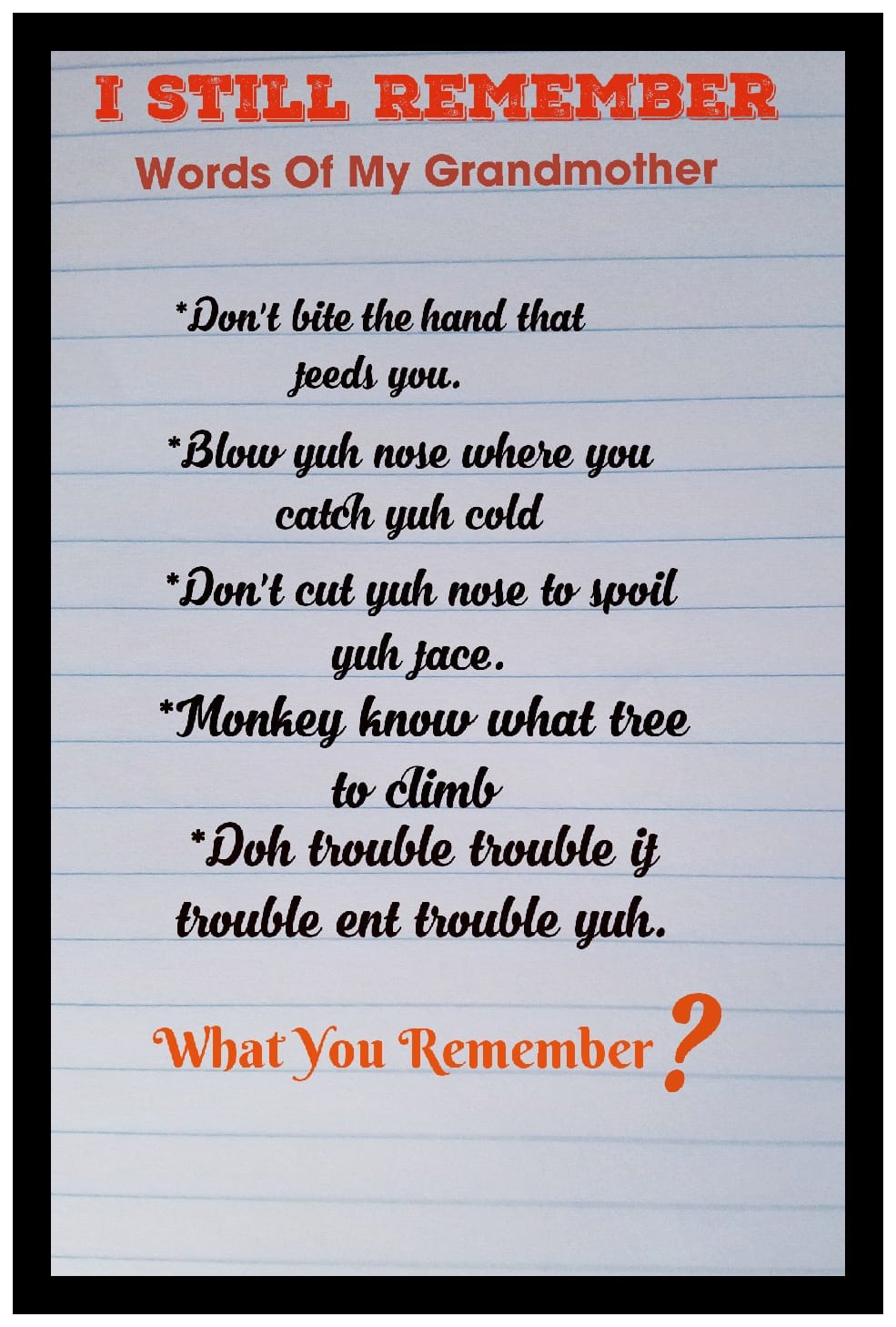|
If you were a child of the 80s and stumbled into adulthood in the 90s, you will recall the lone television station TTT, the Panorama newscast, and its weatherman for our two seasons – Robin Maharaj. Maharaj was the one who educated us about the evil Inter Tropical Convergence Zone (the ITCZ), the approaching storms, and that the waves were probably going to be two metres high in open waters, and one in sheltered areas. Even the worst weather news, Maharaj, dapper in shirt jack or suit, delivered with an engaging smile and perfectly groomed sideburns and pompadour. His most memorable moment on TV for us, of course, would be his 'Rain in dey muda$$ tonight!', comment that accidentally went live, a line so perfect in its Trinidadianess that it lived on…long after TTT died. Around the time State-owned TTT went out of business, Maharaj vanished from public view. And when CNMG went on air, there were new weathermen and women to tell us about how hot or rainy it was going to be tomorrow. And we would hear nothing much of Maharaj, until earlier this month, when the rains of biblical proportions began the night before Divali and lasted for six days. Maharaj became a meme, and middle-aged Trinis demanded his return, with long discussions about his forecasting ability and the need for people with expertise to share reliable information before we were all washed into the sea with the fridges and car parts. We found Robin Maharaj. He lives thousands of miles away. But he has been following local events for decades. And his life has been epic. This is his story: Dades Trace is tiny agricultural-based village near Rio Claro that was once connected to Port of Spain by the railway lines of the Trinidad Government Railway. When the railway system closed in 1968, the village suddenly became a distant place. (You can read about this place in the Express story titled “Defending the Bridges”).
This is the birthplace of Maharaj, born October 1942, educated in Rio Claro and academically gifted enough to make it into the Naparima College in San Fernando. Maharaj would go on to get his credentials at the Caribbean Meteorological Institute in Barbados and Pennsylvania State University in the United States. He told us: “I joined The TT Met service in 1964 as a Meteorological Assistant; then trained at the US Naval Base in Chaguaramas to man and operate the US upper air weather station when the US Navy left in 1966. Became a meteorologist in 1972 following a two year training course in Barbados, at the Caribbean Meteorological Institute. My job in the TT Met Office was mainly weather forecasting for aviation and maritime services, as well as making local public weather forecasts. Importantly, I first did the TV weathercast on TTT on Sept 5, 1972. My last was on December 17, 1999. In between, I completed around 4,000 on-air forecasts, comprised of individual local, international and special occasion forecasts and interviews. In 1999, I left the TnT Met Service where I was Chief Meteorologist, and also the TTT Chief Meteorologist, to take up a job as a Senior Meteorological Scientific Professional at the World Meteorological Organization (WMO), at its Headquarters in Geneva, Switzerland. WMO is a UN Agency. This posting was feather in the cap of Trinidad and Tobago, as the job was advertised globally. The government of the day showed appreciation by awarding me the Medal of Merit for my local career in meteorology, at the 2000 Independence Day Ceremony. At the WMO, my experience, research and expertise in both meteorology and weather broadcasting were utilized in coordinating and organizing global activities and training in weather forecasting, weather broadcasting, and devising/designing and packaging weather office products for a wide spectrum of public users. And most importantly, I was tasked with assisting Met Services in the developing countries to boost their capabilities in severe weather forecasting and warning, with a view to promoting the safety and security of populations and property. This entailed direct training, preparation of training manuals and use of whatever scientific, professional experts/expertise we could garner from member countries, on projects. It was a great experience and my wife Grace and I enjoyed our stay in Switzerland. The job entailed lots of travel and that was a bonus. I retired in 2005 and we migrated to Minnesota, USA, since our only two children, (two boys, the older - Gary - being a highly respected, veteran CEO of biomedical engineering device companies; and the second - Glenn - is a biomedical engineering expert working in research and development), and grandchildren, reside there. Our grandson is a cardiologist and one granddaughter, also a physician. Residing near the core family in the USA was merely a decision to be with our family and see our grandchildren grow, not just to not return to Trinidad. In retirement, I continued by being very active in the meteorological and environmental sciences, and did produce work and advice in these areas. In addition, over the years I have also written articles and letters to media in different countries, including TT, on pertinent topics and issues, not only weather-related. I am a strong defender of things meteorological, and that includes the Trinidad and Tobago Met Service. My advice has been sought by a few meteorological services in consultative capacity. You may recall the energy accident at the Fukushima Daiichi Nuclear Power Plant in Fukushima, initiated primarily by the tsunami following the Tōhoku earthquake on 11 March 2011. After the nuclear event, my opinion was sought on Fox News TV here in the USA about the prospects of the spread of radiation in the USA. Excerpts of the interview were played for two days following. While my interest in meteorology remains high, I have pursued another interest that is more in line with health and lifestyle plans. When I did my first weathercast on TTT in 1972 I weighed 135 lb. When I completed my last weather report 27 years after, I was 165 lb. The TV screen was challenged for space and by age 61 in 2003, I was hitting the scale at over 185 lb. The UN Medical Staff in Geneva, Switzerland, began predicting a range of possible health issues if I did not lose the excess avoir du pois. My wife, Grace, who kept active and controlled her weight since we met in High School, began insisting I allow her to take control, which she did. She designed a rigid regime of exercise and diet to preempt the dismal forecasts of the UN Doctors and carve a path to my good health. My exercise was primarily walking fast, and long distances on outdoor trails. Under her guidance, I lost 30lb before I retired in 2005. When we migrated to live in Minnesota, USA in 2005, I took personal charge of my exercise regime and walked through all seasons, up to 340 days yearly, completing up to 2,500 miles annually, and my weight dropped to 140lb by 2007. During the winters in MinneSNOWta I faced temperatures down to minus 35C, with wind chills below minus 50C. It took true grit and gumption. Then I fell on the ice a few times during the winter of 2011 and the family decided I must not walk outdoors when it is icy. So, I joined a nearby gym in my 70th year. I changed to walking three days weekly between April and October (warmer) and doing gym on the other days. Grace is with me always at the gym, and several times on the walking trails. At the gym my weight increased a bit as I am getting a bit muscular. I weigh 145lb today and I feel strong, healthy and positive. News of my distance walking have spread to several colleagues, friends and relatives. Some call me Mahal, after the famous Trini walker of yester years. But there was a difference over the past 5 years since I started walking between 3am and 4am, in predawn dark, giving me free reign in our safe and well-lit community, and at a rate of 4 mph. When it dawns, I hit the trails around the lakes here and I would complete between 12 and 20 miles, up to three times weekly, before breakfast. On occasion, and for special reasons, I have completed walking marathons in the past few years. How long can I keep this up I have no way of predicting but I see no way that I will give up my current lifestyle. We no longer diet – we eat sensibly. Just say we eat with moderation in moderation. Over the years I used to cook occasionally for the family. In retirement, I do all the cooking. Grace cleans, does laundry and instructs me. We limit oil, fat and carbohydrates. We burn lots of calories daily through exercise and maintaining a high metabolism. We do not eat out, not at McDonalds or in restaurants. I do not eat it if it is in a pack. I drink only water, not even coffee. Of course, we cook versions of TRINI MEALS but we eat based on the saying, IN THE MORNING EAT LIKE A KING, FOR LUNCH EAT LIKE A PRINCE, BUT FOR SUPPER EAT LIKE BEGGAR. Earlier this year our gym chose Grace and me as the Valentine's Day couple. I keep active around the house as a handyman, landscaper, fixer of anything, so call me a Jackofalltrades. I remain alert and physically strong, lifting heavy things and taking them up the stairs. I am pushing the envelope and trying to show that being 75 is not as limiting as many think. It has been a wonderful life, one that has been rewarding in many ways. The one I wish to mention is the public recognition of my work in weather; that approval helped me improve and to fine-tune my talent. There were times when I might have invited opprobrium, but the kind people stressed my strengths, abilities and talent, and led me to believe in myself. This went on for the period 1972-1999, when I was the public face of the TT Met Service, and I definitely appreciate the public esteem and kindness over that time. To find that some people remember me on TTT, or from having met me in my public role, is most touching. The internet is a wonderful means of communication and from time to time I am regaled with funny stories or pictures reminding me of my weathercasting days. The one that keeps recurring carries the headline RAIN IN DEY MUDDA ASS TONITE. Did I say that? Let me tell you what the true story is. While standing by to get the Floor Manager's cue to go ON AIR, and waiting for a commercial to finish, I was asked by the crew leader to give a final test on the microphone. We were always joking and kicksing during breaks so I tested the mic by speaking and summarized the forecast by saying IS RAIN IN DEY MUDDA ASS TONITE. It was a test, not on air. But the Director had the channel ON AIR. Blooper? Not really. This was in July 1994, if I recall well. DJs and Calypsonians made mincemeat of that and I got news from several people over the years, of the line becoming mostly famous, rather than infamous. But I know I am not remembered for that only. I keep reading of Trinidad's excessive floods resulting for heavy and persistent rainfall, and causing havoc and suffering. Rainfall is an act of nature. I also venture to say that some floods due to heavy rain are unavoidable eventualities. The sheer volume of water is way too much for the natural drainage systems. But the latter are modified by man, his public works, engineering, construction of buildings, roads and pavements. In the process the ground component of the water cycle is severely corrupted and even annulled in places, causing general incapability of the landscape to cope with heavy rainfall, and leaving many people quite vulnerable to property damage and loss of life. I am certain everybody knows the cause of the problem; I am also certain that the solution is known to authorities with the appropriate responsibility. However, it takes care and understanding of the related issues, and a will and intent to solve the flooding problem. Posturing in government, among officials and regulators prevents flood mitigation. Evidently, there is need for a comprehensive analysis of every square foot of ground to create a data system to help analyze the related hydrological issues peculiar to localities. It means measuring and documenting everything from land shape and form, geology, tree and shrub cover, drainage, human dwelling and agriculture etc. With that in hand, and with a knowledge of the historical behavior of heavy rainfall in locations, planners can then define what public and environmental works are required to prepare the area from severe flooding. And too, what regulators must insist residents do to prevent and/or cope with dangerous flooding. I am certain that no such comprehensive endeavor has ever been made in Trinidad. Indiscriminate and unchecked land development, along river basins and on the hill slopes have aggravated flooding. Any action leading to changing of the behavior of surface water flow needs to be regulated and controlled. There are regulations in the books but inadequate regulators to enforce the rules and laws. Even so, bribe-taking corrupts the system allowing for rampant disfiguration of the landscape and flooding. Ordinary people need to take action to force the authorities to do their work and ensure flood attenuation and diminishment. Source: Daily Express, March 29, 2021 Jewelry has been a significant adornment for Indian women since ages. Its significance in an Indian woman’s life can be judged from the number of jewelry gifts she receives on a variety of auspicious occasions in her life and how even the poorest of women possess some kinds of jewelry they can afford. Indian women’s decorating themselves with jewelry is not only a customary tradition, but also has a lot of values attached to each and every jewelry piece worn by the women. Why is Jewelry Important for Indian Women? Apart from increasing the beauty of Indian women, Indian jewelry is also considered to be a matter of great security in time of financial crisis due to its good value. To accentuate the feminism factor, women wear jewelry created with precious metals like gold, silver and diamonds. Traditionally, having a good collection of jewelry symbolizes power, good status and immense wealth of the owner. Jewelry and Indian women share a deep connection as its value lies not only in traditions, but also has a great significance in scientific terms. We must understand the reason behind each jewelry piece adorned by Indian women as it lies deep rooted in science. It would certainly increase our love and respect for Indian women’s jewelry. Wide Variety of Indian Jewelry Adorned by Women Jewelry designs are available in a wide variety in India as each state has its own culture and jewelry is made accordingly to highlight the values of those traditions. Some of the most commonly used jewelry by Indian women includes maangtika, nose rings, necklace, earrings, mangalsutra and bangles. Now, let’s understand the significance and the logic behind each piece of jewelry worn by Indian women. Here we have a list of some of the most commonly worn jewelry pieces with their cultural and scientific significance Tika Tika consists of a chain with a pendant in the front and a hook at the other end. The hook is used for holding the tika at the hair end, while the pendant embellishes the center of the woman’s forehead. A woman’s forehead, especially the center part is believed to be the place of chakra which refers to preservation. Traditionally, the chakra is visualized to have two petals where the half-male and half-female androgynous deity Ardhanarishvara resides. It symbolizes the final union where there is no division. In view of science, this union is the meeting of the male and female elements in nature at both the physical and the mental level Nose ring: Nose ring called as nath by Indian women is definitely the most seductive jewel piece without which a married woman’s make up is considered incomplete. It forms an integral part of traditional bridal jewelry keeping in view its conventional and scientific value. Aristocratic families get special nose rings created for the bride as it’s considered the most auspicious jewel to be worn on the occasion. Scientifically, it is believed that women having pierced nose experience less pain during childbirth. Ayurveda considers it a valuable piece which is worn on the spot directly connected with the health of the female reproductive organs. As per a theory, nose ring is also connected to emotional, romantic and sexual propositions of a woman. It also prevents a woman from being hypnotized due to its power to control the brain wavelength. It is one of the most fascinating jewelry pieces worn by both married and unmarried women. Available in a wide variety of shapes, colors and sizes, it attracts every woman towards it and makes an important part of the woman’s fashion accessories. Matching earrings with garments enhance the attraction quotient manifold. As per the famous legends, evil spirits were believed to enter the body through any of its openings. By wearing ornaments in the ear, the woman attained a state of complete well being. The latest studies have also revealed that ear is a microcosm of the entire body and has an important nerve that connects cervix, brain and kidney. By applying the right amount of pressure in the right ear to which the nerve of the kidney is connected, the health of the kidney and the bladder can be taken care of. Necklace: Necklaces worn near the heart are believed to control emotions and strengthen one’s love. Wearing a necklace of stones is believed to bind ourselves with their eternal powers. Since ancient times, necklaces, pendants, strings of beads and elaborate ornamental collars were worn by women to bring good luck and ward off the evil eye. The necklace is also believed as a protective ornament against hypnotizing as such attempts are successfully undermined. So, this neck ornament not only adds an exquisite look to a women’s beauty, but also acts as a potent restraint against effects of evil charms on virtuous maidens. Bangles: Bangles, the word itself seem to fill one with the sweet tinkling sound produced by it! Wearing bangles can be easily afforded by any woman whether rich or poor as it is available in almost all metals from highly precious ones to wooden bangles. The attractive designs in which bangles are available make it even more stunning and a woman’s beauty is considered incomplete without ornamenting with it. Apart from being an important ornament worn by a married woman, this ornament also has immense romantic and amorous connotations as well. The sound of a woman’s bangles expresses her presence and her wish to gain attention. Scientifically, it is known to increase a woman’s blood circulation level and channelize the energy passing through her outer skin. This is made possible by the circular shape of the ornament with the cute tinkling sound Toe rings: The most eminent scientific theory behind wearing toe rings is its help in making menstrual cycle regularized which is a common problem faced by women. The nerves in toes are connected to the uterus and passes through the heart. While a married woman does her chores while wearing these rings, the friction created help in revitalizing her reproductive organs. As toe rings are generally made of silver, it absorbs energy from the earth and refreshes the entire body of the woman by passing the energy to it. Ring: Wearing a ring on the fourth finger from the thumb is directly connected to the nerve passing through this finger to the brain neuron cells. With metallic friction, women attain good health and get confidence to handle life with ease. The wedding ring worn in the middle finger is believed to be directly connected with the heart which helps in controlling the wearer’s emotions. Nowadays, rings of various stones are worn by women for various health benefits attached to a variety of gem stones. Mangalsutra:
Mangalsutra is believed to control body pressure levels and make blood circulation regular in the body of the woman wearing it. Traditionally, the bridegroom gives it to the bride during the wedding and it is worn by the married woman symbolizing feelings of love and commitment between the married couple. Hip/Belly Belt: Hip or popularly known as belly belts are not regularly used by women, but only during wedding or some festive occasions. Nowadays, it is also used by many women in modern designs to add to their glam quotient. Scientifically, these belts are believed to prevent saturation of fat in the waist and help in maintaining a woman’s figure. This describes why a woman does ‘solah shringar’ as it’s not only to add to her beauty, but for various other logical reasons attached to it. Source: Cultural India.net February 10, 2021 All Yuh Remember Sunday Morning Market!! The Vendors Outside The Market Use To Have Some Good Deals! Ent Source: Carl Nelson, Trinbago Golden Memories, Jan 31, 2021
People used to use urine to tan animal skins, so families used to all pee in a pot & then once a day it was taken & Sold to the tannery.......if you had to do this to survive you were "Piss Poor"
But worse than that were the really poor folk who couldn't even afford to buy a pot......they "didn't have a pot to piss in" & were the lowest of the low The next time you are washing your hands and complain because the water temperature isn't just how you like it, think about how things used to be. Here are some facts about the 1500s: Most people got married in June because they took their yearly bath in May, and they still smelled pretty good by June.. However, since they were starting to smell . ...... . Brides carried a bouquet of flowers to hide the body odor. Hence the custom today of carrying a bouquet when getting Married. Baths consisted of a big tub filled with hot water. The man of the house had the privilege of the nice clean water, then all the other sons and men, then the women and finally the children. Last of all the babies. By then the water was so dirty you could actually lose someone in it.. Hence the saying, "Don't throw the baby out with the Bath water!" Houses had thatched roofs-thick straw-piled high, with no wood underneath. It was the only place for animals to get warm, so all the cats and other small animals (mice, bugs) lived in the roof. When it rained it became slippery and sometimes the animals would slip and fall off the roof... Hence the saying "It's raining cats and dogs." There was nothing to stop things from falling into the house. This posed a real problem in the bedroom where bugs and other droppings could mess up your nice clean bed. Hence, a bed with big posts and a sheet hung over the top afforded some protection. That's how canopy beds came into existence. The floor was dirt. Only the wealthy had something other than dirt. Hence the saying, "Dirt poor." The wealthy had slate floors that would get slippery in the winter when wet, so they spread thresh (straw) on floor to help keep their footing. As the winter wore on, they added more thresh until, when you opened the door, it would all start slipping outside. A piece of wood was placed in the entrance-way. Hence: a thresh hold. In those old days, they cooked in the kitchen with a big kettle that always hung over the fire.. Every day they lit the fire and added things to the pot. They ate mostly vegetables and did not get much meat. They would eat the stew for dinner, leaving leftovers in the pot to get cold overnight and then start over the next day. Sometimes stew had food in it that had been there for quite a while. Hence the rhyme: Peas porridge hot, peas porridge cold, peas porridge in the pot nine days old. Sometimes they could obtain pork, which made them feel quite special. When visitors came over, they would hang up their bacon to show off. It was a sign of wealth that a man could, "bring home the bacon." They would cut off a little to share with guests and would all sit around and chew the fat. Those with money had plates made of pewter. Food with high acid content caused some of the lead to leach onto the food, causing lead poisoning death. This happened most often with tomatoes, so for the next 400 years or so, tomatoes were considered poisonous. Bread was divided according to status. Workers got the burnt bottom of the loaf, the family got the middle, and guests got the top, or the upper crust. Lead cups were used to drink ale or whisky. The combination would Sometimes knock the imbibers out for a couple of days. Someone walking along the road would take them for dead and prepare them for burial.. They were laid out on the kitchen table for a couple of days and the family would gather around and eat and drink and wait and see if they would wake up. Hence the custom of holding a wake. England is old and small and the local folks started running out of places to bury people. So they would dig up coffins and would take the bones to a bone-house, and reuse the grave. When reopening these coffins, 1 out of 25 coffins were found to have scratch marks on the inside and they realized they had been burying people alive... So they would tie a string on the wrist of the corpse, lead it through the coffin and up through the ground and tie it to a bell. Someone would have to sit out in the graveyard all night (the graveyard shift.) to listen for the bell; thus, someone could be, saved by the bell or was considered a dead ringer. Now, whoever said History was boring? Rare Photographs of the Lennon’s and Starkey’s During Their Holiday in Trinidad and Tobago, 196611/12/2020 John and Cynthia Lennon, Ringo Starr and his wife Maureen Starkey all flew to Port of Spain in Trinidad for a winter holiday. The group flew from London Airport to Piarco International Airport, a short drive from Port of Spain. The group spent some relaxing moments with Dr. Eric Williams and his daughter Erica at Bacolet Bay, Tobago. They returned to England on 23 January 1966. To see photos, click here Source: Vintage Everyday, August 2020
|
T&T news blogThe intent of this blog is to bring some news from home and other fun items. If you enjoy what you read, please leave us a comment.. Archives
May 2025
Categories
All
|












 RSS Feed
RSS Feed